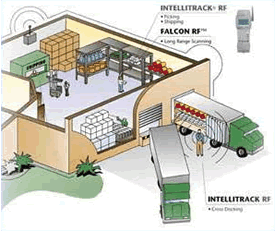 Radio Frequency
Transmission of Data Radio Frequency
Transmission of Data
RF transmission provides "real time" data
entry without using a tethered scanner. Many applications require
the user be too far from a computer terminal to use a bar code
scanner cabled to the terminal (such as warehouse and shipping
applications). In these cases, data can be collected into
a handheld data collection
unit, then downloaded at regular intervals to the computer;
this is
batch data entry.

If data is needed "real time" (instantaneously), a bar
code scanner equipped with a radio frequency transmitter can be used.
The radio waves are picked up by the RF receiver connected to the
computer. All kinds of devices are equipped with RF, including bar
code scanners, handheld data collection terminals, truck-mounted terminals,
and PCM/CIA cards.
 Radio Frequency
Identification Technology Radio Frequency
Identification Technology
RFID is used to automatically identify, categorize, and locate people
and assets over relatively short distances (a few inches to
hundreds of feet). RFID labels
are known as "tags" or "transponders". They contain information
ranging from an ID number to 128K bytes. Then an RFID "interrogator" is
used to send out an RF signal which "wakes up" the tag, and
the tag transmits information back to the interrogator via RF.

At this point,
the interrogator
can write new information to the tag. This enables the user to alter the
information stored in the tag from a distance. Interrogators can be networked
together
to provide nearly unlimited coverage for a system.
RFID is being used for:
- Identifying objects in harsh environments
- WIP tracking of items through the manufacturing cycle
- Personal identification/access control
- Identifying vehicles on roadways, as well as for automatic
toll collection
- Tracking rail cars so railroads have real-time location data
of their rail cars
- Identifying trucks for trucking companies and intermodal container
carriers
- Providing automated inventory and location of assets
|